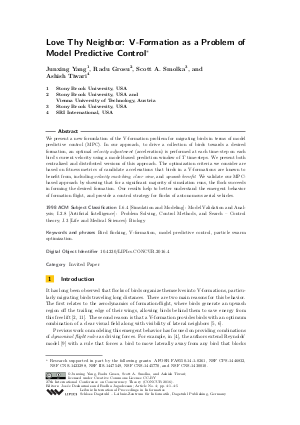Love Thy Neighbor: V-Formation as a Problem of Model Predictive Control (Invited Paper)
Authors Junxing Yang, Radu Grosu, Scott A. Smolka, Ashish Tiwari
-
Part of:
Volume:
27th International Conference on Concurrency Theory (CONCUR 2016)
Part of: Series: Leibniz International Proceedings in Informatics (LIPIcs)
Part of: Conference: International Conference on Concurrency Theory (CONCUR) - License:
 Creative Commons Attribution 3.0 Unported license
Creative Commons Attribution 3.0 Unported license
- Publication Date: 2016-08-24
File

PDF
LIPIcs.CONCUR.2016.4.pdf
- Filesize: 451 kB
- 5 pages
Document Identifiers
Subject Classification
Keywords
- bird flocking
- v-formation
- model predictive control
- particle swarm optimization
Metrics
- Access Statistics
-
Total Accesses (updated on a weekly basis)
0Document
0Metadata
Abstract
We present a new formulation of the V-formation problem for migrating birds in terms of model predictive control (MPC). In our approach, to drive a collection of birds towards a desired formation, an optimal velocity adjustment (acceleration) is performed at each time-step on each bird's current velocity using a model-based prediction window of $T$ time-steps. We present both centralized and distributed versions of this approach. The optimization criteria we consider are based on fitness metrics of candidate accelerations that birds in a V-formations are known to benefit from, including velocity matching, clear view, and upwash benefit. We validate our MPC-based approach by showing that for a significant majority of simulation runs, the flock succeeds in forming the desired formation. Our results help to better understand the emergent behavior of formation flight, and provide a control strategy for flocks of autonomous aerial vehicles.
Cite As Get BibTex
Junxing Yang, Radu Grosu, Scott A. Smolka, and Ashish Tiwari. Love Thy Neighbor: V-Formation as a Problem of Model Predictive Control (Invited Paper). In 27th International Conference on Concurrency Theory (CONCUR 2016). Leibniz International Proceedings in Informatics (LIPIcs), Volume 59, pp. 4:1-4:5, Schloss Dagstuhl – Leibniz-Zentrum für Informatik (2016)
https://doi.org/10.4230/LIPIcs.CONCUR.2016.4
BibTex
@InProceedings{yang_et_al:LIPIcs.CONCUR.2016.4,
author = {Yang, Junxing and Grosu, Radu and Smolka, Scott A. and Tiwari, Ashish},
title = {{Love Thy Neighbor: V-Formation as a Problem of Model Predictive Control}},
booktitle = {27th International Conference on Concurrency Theory (CONCUR 2016)},
pages = {4:1--4:5},
series = {Leibniz International Proceedings in Informatics (LIPIcs)},
ISBN = {978-3-95977-017-0},
ISSN = {1868-8969},
year = {2016},
volume = {59},
editor = {Desharnais, Jos\'{e}e and Jagadeesan, Radha},
publisher = {Schloss Dagstuhl -- Leibniz-Zentrum f{\"u}r Informatik},
address = {Dagstuhl, Germany},
URL = {https://drops.dagstuhl.de/entities/document/10.4230/LIPIcs.CONCUR.2016.4},
URN = {urn:nbn:de:0030-drops-61896},
doi = {10.4230/LIPIcs.CONCUR.2016.4},
annote = {Keywords: bird flocking, v-formation, model predictive control, particle swarm optimization}
}
Author Details
References
-
Eduardo F Camacho and Carlos Bordons Alba. Model Predictive Control. Springer Science &Business Media, 2013.

-
C Cutts and J Speakman. Energy savings in formation flight of pink-footed geese. The Journal of Experimental Biology, 189(1):251-261, 1994.

-
G Dimock and M Selig. The aerodynamic benefits of self-organization in bird flocks. Urbana, 51:61801, 2003.

-
Gary William Flake. The Computational Beauty of Nature: Computer Explorations of Fractals, Chaos, Complex Systems, and Adaptation. MIT Press, 1998.

-
WJ Hamilton. Social aspects of bird orientation mechanisms. Animal Orientation and Navigation,, pages 57-71, 1967.

-
Frank H Heppner, Jeffrey L Convissar, Dennis E Moonan Jr, and John GT Anderson. Visual angle and formation flight in Canada geese (Branta Canadensis). The Auk,, pages 195-198, 1985.

-
Dietrich Hummel. Aerodynamic aspects of formation flight in birds. Journal of Theoretical Biology, 104(3):321-347, 1983.

-
Andre Nathan and Valmir C Barbosa. V-like formations in flocks of artificial birds. Artificial Life, 14(2):179-188, 2008.

-
Craig W Reynolds. Flocks, herds and schools: A distributed behavioral model. In ACM Siggraph Computer Graphics, volume 21, pages 25-34. ACM, 1987.

-
Forrest Stonedahl and Uri Wilensky. Finding forms of flocking: Evolutionary search in ABM parameter-spaces. In Multi-Agent-Based Simulation XI, pages 61-75. Springer, 2011.

-
Henri Weimerskirch, Julien Martin, Yannick Clerquin, Peggy Alexandre, and Sarka Jiraskova. Energy saving in flight formation. Nature, 413(6857):697-698, 2001.

